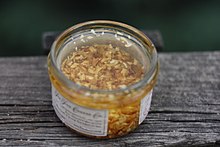Garlic oil is the volatile oil derived from garlic.[1] It is usually prepared using steam distillation, and can also be produced via distillation using ether. It is used in cooking and as a seasoning, a nutritional supplement, and also as an insecticide.
Preparation[edit]
Garlic oil is typically prepared using steam distillation,[1] where crushed garlic is steamed with the resultant condensation containing the oil.[2] Garlic oil contains volatile sulfur compounds such as diallyl disulfide, a 60% constituent of the oil.[1][3][4][5] Steam-distilled garlic oil typically has a pungent and disagreeable odor and a brownish-yellow color.[6] Its odor has been attributed to the presence of diallyl disulfide.[1][6] To produce around 1 gram of pure steam-distilled garlic oil, around 500 grams of garlic is required.[2] Undiluted garlic oil has 900 times the strength of fresh garlic, and 200 times the strength of dehydrated garlic.[6]
Ether can also be used to extract garlic oil.[2] A type of garlic oil involves soaking diced or crushed garlic in vegetable oil, but this is not pure garlic oil; rather it is a garlic-infused oil.[2]
Uses[edit]
Garlic oil is used as a dietary supplement or digestive aid commonly sold in capsules, which may be diluted with other ingredients.[1][2] Some commercial preparations are produced with various levels of dilution, such as a preparation that contains 10% garlic oil.[6] There is no clinical research confirming health effects of consuming garlic oil.[1]
Stabilized garlic flavor blend is a proprietary mixture of dehydrated garlic powder infused with garlic oil, which increases the flavor of the garlic powder.[7]
Garlic oil can be used as an insecticide, diluted with water and sprayed on plants.[8][9]
Potential adverse effects[edit]
Common adverse effects of consuming garlic, garlic oil, and garlic supplements are breath and body odor, abdominal pain, nausea, vomiting, and other symptoms of gastrointestinal disorders.[1] Garlic oil consumption may have anticoagulant effects in some people, causing bleeding, and may interfere with prescription drugs.[1]
Garlic-flavored oil[edit]

Garlic-flavored oil is produced and used for cooking and seasoning purposes, and is sometimes used as an ingredient in seasoning mixtures.[2][6] This differs from essential garlic oil, and typically involves the use of chopped, macerated or crushed garlic placed in various vegetable oils to flavor the oil.[1]
See also[edit]
References[edit]
- ^ a b c d e f g h i "Garlic and organosulfur compounds". Micronutrient Information Center, Linus Pauling Institute, Oregon State University. 1 September 2016. Retrieved 8 June 2022.
- ^ a b c d e f Stanway, P. (2012). The Miracle of Garlic: Practical Tips for Health & Home. Watkins Media. p. 25. ISBN 978-1-78028-607-5. Retrieved December 29, 2017.
- ^ Kenneth T. Farrell (1999), Spices, condiments, and seasonings (2nd ed.), Gaithersburg, Md.: Aspen Publishers, p. 101, ISBN 0-8342-1337-0
- ^ Dennis J. McKenna (2011), Botanical Medicines : the Desk Reference for Major Herbal Supplements. (Second ed.), New York: Routledge, p. 377, ISBN 978-1-136-39356-3
- ^ Hans Ferdinand Linskens (1991), Essential Oils and Waxes, Berlin, Heidelberg: Springer Berlin Heidelberg, p. 105, ISBN 978-3-642-84023-4
- ^ a b c d e Farrell, K.T. (1998). Spices, Condiments and Seasonings. Chapman & Hall food science book. Springer US. p. 101. ISBN 978-0-8342-1337-1. Retrieved December 29, 2017.
- ^ Indian Spices. Spices Export Promotion Council. 1996. p. 46. Retrieved December 29, 2017.
- ^ Ellis, B.W.; Bradley, F.M.; Atthowe, H. (1996). The Organic Gardener's Handbook of Natural Insect and Disease Control: A Complete Problem-Solving Guide to Keeping Your Garden and Yard Healthy Without Chemicals. Rodale Books. p. 473. ISBN 978-0-87596-753-0. Retrieved December 29, 2017.
- ^ Baser, K.H.C.; Buchbauer, G. (2015). Handbook of Essential Oils: Science, Technology, and Applications, Second Edition. CRC Press. p. 659. ISBN 978-1-4665-9047-2. Retrieved December 29, 2017.
